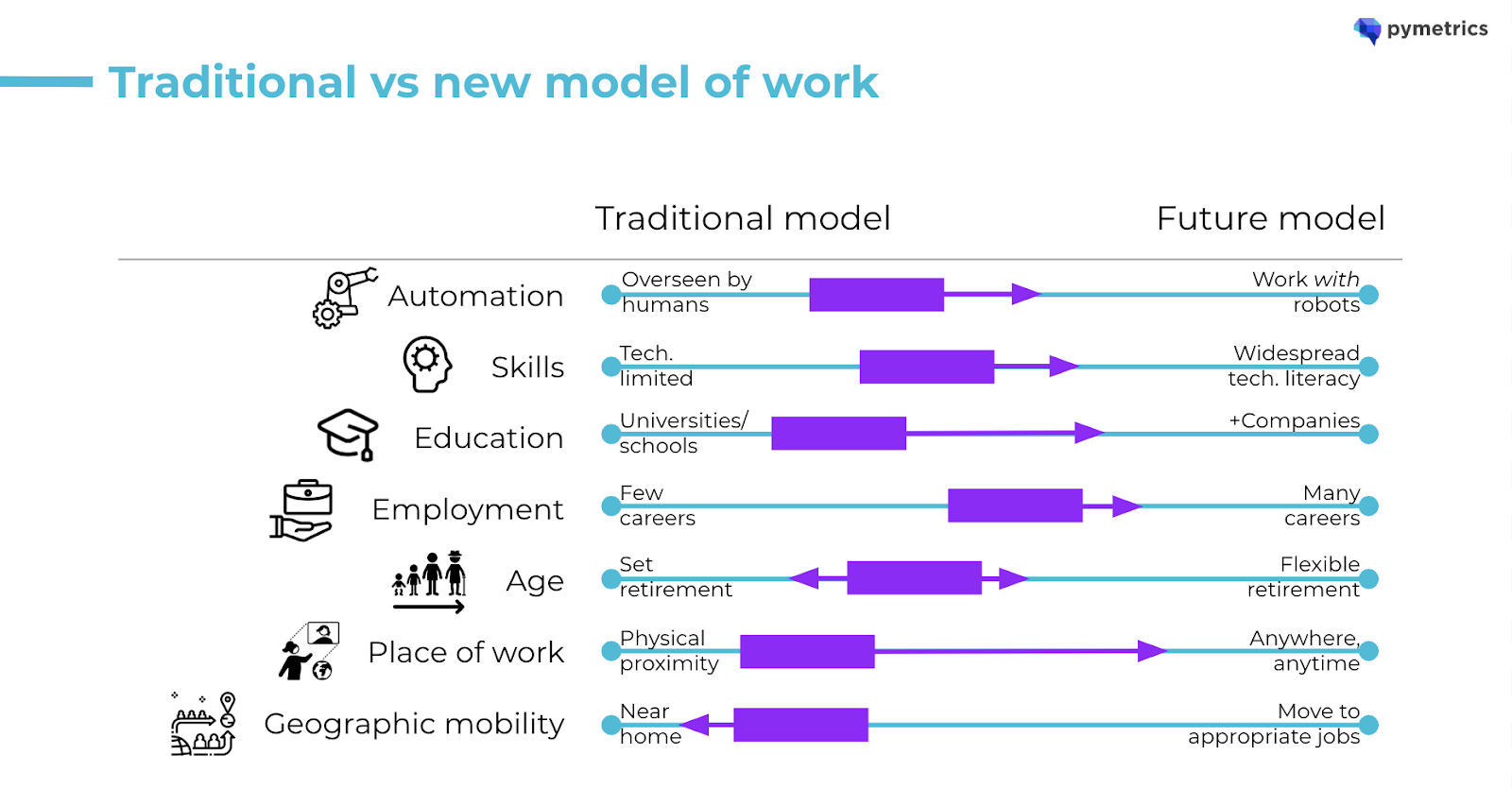The Future of Work is Now: The State of Work Today
Originally published by pymetrics on 26 May, 2020
Written by Theo Roos
“Opening offices will be our decision. When and if our employees come back, will be theirs.”
The last few months have undoubtedly upended some long-held beliefs on how we work. But in many instances, it has simply accelerated longer-term trends - albeit doing so in three months what many had predicted to take three years or even three decades.
Analysing what the future model of work could look like, we took seven key dimensions that help explain the shifts we are seeing, and their acceleration (or not) over the past few months.
With automation, we have been moving to a world where machines use artificial intelligence to perform most repetitive tasks (both physical and cognitive), with minimal human oversight. There is some way to go to achieve this full future state, but this trend has been accelerated by the short-term necessity for businesses to maintain capability and capacity with reduced human oversight, and the wider use of new technologies such as 3D printing and augmented or virtual reality.
With skills, the future will require technological literacy as a basic requirement for almost all jobs in every industry. But ‘softer skills’ such as grit and adaptability will also become crucial to employees’ success, in order to keep up with the ever-increasing pace of change. The transformation of digital industries in the past decade has moved us closer to this new model, but some industries have been relatively insulated from these trends. With many employees having more downtime to develop, as well as the supply of remote, personalised, often ‘on the job’ learning, we should expect this to become more widespread and pick-up more rapidly from now on.
With education, companies and employees themselves will take more responsibility for learning - that in turn will take place beyond the traditional education age and location of school and university. This lifelong learning, given the recent technological developments and personalisation, has taken a big leap in recent months with the uptake of (often self-directed) remote and online courses, and set trends for the future which will continue at pace.
With employment, big strides have taken place this century in terms of the number of careers and employers the average person will have within their lifetime. And more recently, the numbers entering the workforce on a freelance or ‘gig’ basis have shot up (with associated implications for employee rights). Given tactical workforce planning necessary to navigate through changing customer demands, as well as new ways of working (e.g. agile teaming), the last few months have again seen acceleration in this trend. This likely has implications for public policy (e.g. around worker benefits and protections) to cushion the impact of more fragility in employer-employee relationships.
With age, employees are moving away from retiring at a set statutory retirement age (and working for specific times during the week). In the future, there will be more working before or during higher education, especially given that that education will be more spread out throughout a worker's lifetime. The impact of COVID on the economy has reversed some of this employee longevity - with some industries seeing an uptick in early retirement - but also more flexible job uptake, countering this retrenchment.
With place of work, the direction of travel is towards people working anywhere (and at any time) within less hierarchical organisations and teams. This is helped by the general shift, experienced by most economies, away from blue-collar work to white-collar work - where computer interface and interaction is the primary worker tool. It is clear to most of us that this trend has seen the largest shift this year, with ‘working from home’ becoming the norm for most white-collar workers in almost all industrialised economies. Fast forwarding beyond the immediate, workplace design will likely change - that is if companies even choose to keep a physical office presence.
Finally, with geographic mobility, the impact of globalisation has resulted in higher-skill employees more likely matching with opportunities regardless of their geographic base - rather than people working just near where they grew up or went to university. One could have foreseen this trend going beyond higher-skill employees in the future, but the public policy reaction to the current pandemic will likely see a slowing or even reversal of this trend - at least in the short to medium term.
Whilst we are therefore definitely leaving the ‘traditional model’ of work behind in almost all cases, and in most cases accelerating faster towards the future, this isn’t universal across all trends. These are generalisations across economies, and the full extent of this will, of course, differ by industry and geography. It is up to all of us, as employers, employees and other stakeholders to shape the future of work for all of our benefits.
pymetrics, a Partner of Thrive HR Exchange, is an enterprise talent platform that makes workforce decisions more efficient, accurate, and fair. We use behavioural science-backed exercises to measure the cognitive, social, and emotional attributes of individuals and a data-driven approach to match them with the right opportunity - based on their potential, not their pedigree. Our ethical and audited AI-powered insights and recommendations equip leaders with accurate and actionable information to manage the entire talent lifecycle, from hiring to internal mobility and beyond.


